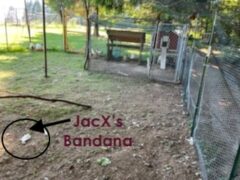Many of you have asked who killed my chickens. If you haven’t been following my ongoing chicken mama saga, you can find my last article here. But, just to quickly summarize, something killed six of my eight chickens, leaving a traumatized rooster without tail feathers and an unscathed hen.
My husband and I have spent days pondering the demise of our chickens. To answer the question succinctly, we aren’t exactly sure. But there are two clues that shed some light on the answer.
First, one of the chickens was found in our backyard. Our chicken coop is in the front field and requires either walking down the driveway or strolling through the woods to get to the coop. Even back in our short-lived, free-range chicken days, no chicken ever wandered up towards the house. They ran (or flew) for cover in the trees and away from our dogs. So, something brought this chicken to our backyard.
The second clue takes a little to set up, so bear with me. As you may recall, we have a chicken coop enclosed within a 10×10 run with a gate. At the request of our chickens, we expanded this run to include a 20×30 play area that has poultry fencing on the sides and is covered with bird netting. This play area isn’t designed to keep them safe at night, but during the day it does keep them contained, and the netting keeps winged predators out while preventing the chickens from “flying the coop.” Our chicken coop has an automatic door opener, which protects them at night, and when we closed the run gate in the evening, the chickens were also predator-safe. After the chicken massacre, we added chicken coop fencing around the play area and staked it down. And we committed to closing the run gate every night to protect them even more.
In honor of my husband’s birthday, I dressed the dogs in their birthday bandanas from Bailey’s Bandanas. The morning after his birthday, JacX (the puppy) returned to the house after “doing her business” without her bandana. That morning, as I walked up to let the chickens out, I was lamenting that I would have to order another bandana as the dogs look so cute with them on. When I arrived at the chicken coop, I found the bandana. Smack in the middle of the play structure. You know: the one surrounded by chicken coop fencing.
Yep, our “bird dog” used her nose and paws to pry up the stakes, lift the fencing and enter the play structure. Fortunately, the chickens were locked up in the run and she couldn’t get to them.
As I reflect on why JacX would do that, I think she might have started taking “liberties” with her title of bird dog. Instead of thinking of herself as a dog that retrieves the birds her dad shoots, she started to think of herself as a dog who retrieves all birds, regardless of whether her dad shot them.
And while I’m not happy with her at all, I think that in some ways we can all relate to her. How many of us have taken ‘liberties” with our titles or our responsibilities over the past year? Think about it – how many of us have transitioned to less formal business attire while working at home (or at least from the waist down)? Or how many of us have found out that without all the idle chit-chat, we can actually get all our work done 15-20% faster, thus allowing us to shrink our work week? Or perhaps we have “shirked” those responsibilities that we really don’t like doing or never found any value in completing?
As we move into a post-pandemic life, most businesses will start having employees return to work in the office full-time. This will definitely be a period of adjustment. I’d like to propose the following three suggestions on how to preserve the benefits of the past year while ensuring that the company is poised to grow and thrive in this new economy.
- Communicate. Don’t assume your employees know what you have been thinking and planning for the past year. As we teach in EOS, in order for an employee to hear you for the first time, they need to hear it seven times. So, get clear on your vision and your path to achieving that vision and then start communicating. If you feel like you are overcommunicating, or you’re getting tired of repeating yourself, pat yourself on the back and keep on communicating.
- Be clear on everyone’s responsibilities. A year is a long time to firmly establish habits, good or bad. So, as you move towards “re-entry” make sure that everyone is clear on what is expected of them. One EOS tool that I like to use is the 5-5-5. This tool can be used to reinforce core values, describe the employee role in the organization and define their quarterly “rocks” (business priorities).
- Be human. One of the benefits of the past year is the melding together of our personal and professional lives. We have learned how to work from home and balance remote learning for our kids, how to manage barking dogs during Zoom meetings and how to support each other during periods of tremendous stress. My hope is that we maintain that same level of care and concern in our post-pandemic lives.
If you find that you or your workforce isn’t ready to navigate the new realities, please reach out to me. I can provide you some tools and techniques that will make this adjustment much easier for all parties involved. And, perhaps, we can learn how to leverage some of those “liberties” into a more fulfilling life.

